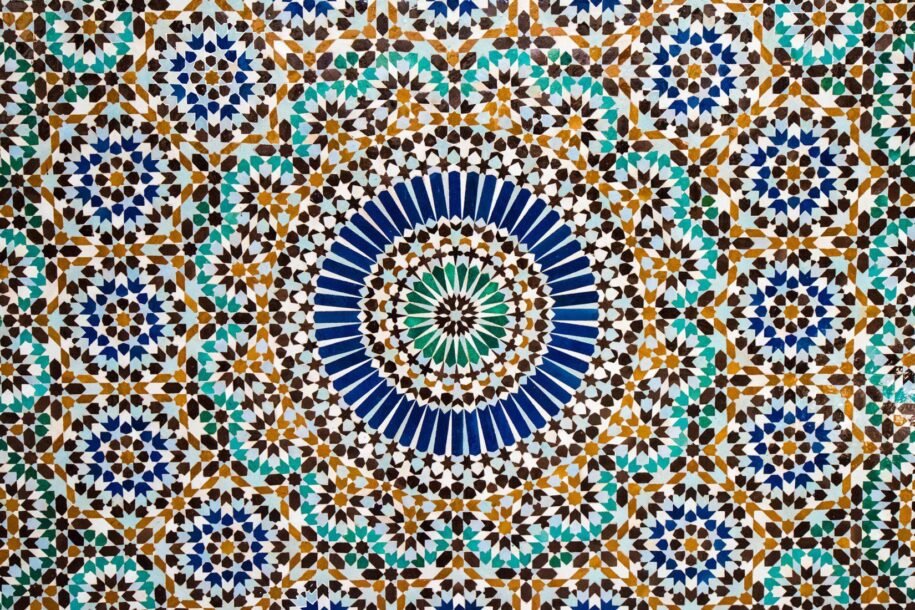Moroccan zellige is one of the most stunning and intricate forms of tile art in the world. It is a centuries-old tradition deeply rooted in Moroccan culture, admired for its vibrant colors, geometric patterns, and exceptional craftsmanship. Whether used to decorate majestic mosques, grand palaces, or modern homes, zellige is a testament to the rich heritage of Moroccan architecture.
What is Moroccan Zellige?
Moroccan zellige is a handmade tile art crafted from natural clay and pigments. These tiles are often used to cover walls, floors, and even fountains, adding an elegant and timeless beauty to any space. The word “zellige” comes from the Arabic word “zallij,” which means “little polished stone,” and this perfectly describes the smooth, glazed surface of these tiles. Each tile is unique, reflecting the hands of the skilled artisans who create them.
Zellige has been an integral part of Moroccan architecture for centuries. It is not just a decorative element; it is also a symbol of cultural identity and tradition. The intricate designs often feature geometric patterns inspired by Islamic art, reflecting the harmony and balance central to Moroccan design philosophy.
How Moroccan Zellige is Made
The process of creating Moroccan zellige is both an art and a science, requiring years of training and practice. It all begins with natural clay, which is carefully collected from local sources. This clay is mixed with water to form a soft paste. Skilled artisans then mold the paste into small square tiles by hand, using simple tools to ensure uniformity.
Once the tiles are shaped, they are left to dry under the sun. Afterward, they are fired in a traditional kiln, a process that hardens the clay and prepares it for the next stage. The firing process is delicate and requires close attention, as even small temperature changes can affect the quality of the tiles.
The most distinctive feature of zellige is its vibrant colors. Artisans use natural pigments derived from minerals to hand-paint each tile. The palette includes deep blues, earthy greens, warm yellows, and brilliant whites. These colors are then locked in with a second firing, giving the tiles their characteristic glossy finish.
Finally, the tiles are carefully cut and polished. Artisans use precision tools to create the intricate shapes needed for geometric patterns. This step requires incredible skill, as even the slightest error can disrupt the harmony of the design.
Incorporating Moroccan Zellige into Your Home
Moroccan zellige is a versatile material that can transform any space into a work of art. Its durability and beauty make it an excellent choice for both traditional and modern interiors. Whether you want to create a bold statement wall or a subtle decorative accent, zellige offers endless possibilities.
In bathrooms, zellige tiles can add a touch of luxury to shower walls or vanity backsplashes. The glossy finish of the tiles reflects light beautifully, creating an airy and elegant atmosphere. Kitchens are another popular space for zellige, where it is often used for countertops, backsplashes, or even flooring. The tiles’ resistance to moisture and heat makes them a practical choice for these areas.
For living rooms or outdoor spaces, zellige can be used to create striking fireplaces, water fountains, or decorative wall panels. The unique patterns and textures of the tiles can add depth and character to any design.
If you are considering using zellige in your home, it is essential to work with skilled craftsmen. Proper installation is crucial to ensure that the tiles last for decades while maintaining their beauty.
Preserving the Heritage of Moroccan Zellige
Despite its cultural significance, the tradition of Moroccan zellige faces several challenges today. Modernization and mass production have led to a decline in the number of artisans practicing this craft. Many clay quarries are becoming scarce, and the demand for cheaper, machine-made tiles is threatening the survival of traditional methods.
To preserve this art form, it is vital to support local artisans and invest in authentic zellige. When you choose handmade tiles, you are not only adding a piece of history to your home but also helping to sustain a craft that has been passed down through generations.
Where Are Zellige Tiles Traditionally Used in Morocco?
In Morocco, zellige tiles have been used for centuries to decorate important places. Mosques are often covered with zellige, especially on walls, floors, and prayer niches, creating a calm and beautiful atmosphere. Palaces also use these tiles to make rooms, courtyards, and fountains look grand and elegant.
Traditional Moroccan homes, called riads, often feature zellige on walls, staircases, and floors, adding charm and warmth. Hammams, or bathhouses, use these tiles because they are strong and can handle heat and moisture.
You can also see zellige in public fountains, gardens, and old city gates, where it brings life and beauty to shared spaces. These tiles are not just decoration—they are a symbol of Morocco’s rich culture and artistic history.
The Future of Moroccan Zellige
While zellige remains a cherished tradition, it is also evolving to meet modern demands. Contemporary designers and architects are finding new ways to incorporate this ancient art into innovative projects. From minimalist patterns to bold color combinations, zellige is being reimagined for the 21st century.
This blend of tradition and innovation is vital for keeping the art alive. By adapting to modern trends while staying true to its roots, Moroccan zellige continues to captivate and inspire.
Why Visit Morocco to Experience Zellige?
Visiting Morocco offers an unmatched opportunity to explore the world of zellige. Cities like Marrakech, Fez, and Meknes are brimming with masterpieces of this tile art. From the intricate mosaics in Bahia Palace to the grand fountains of historic medinas, you’ll witness the incredible craftsmanship that makes zellige so special.
Take your experience a step further by visiting local workshops. Meet skilled artisans who create these tiles by hand, and watch as they mold, paint, and assemble stunning designs. It’s an unforgettable way to connect with Morocco’s artistic legacy.
Ready to explore the artistry of Moroccan zellige and immerse yourself in the country’s vibrant culture? Book your private tour with our Morocco Private Tours. Our curated experiences take you to the heart of Morocco’s architectural and cultural treasures, ensuring you enjoy every moment of your journey.
FAQs About Moroccan Zellige
What Makes Moroccan Zellige Unique?
Its handcrafted nature and vibrant geometric patterns make each piece a work of art. No two tiles are exactly alike.
Is Zellige Durable?
Yes, zellige is highly durable and can withstand both indoor and outdoor conditions. Its glaze also protects it from moisture and stains.
How Do I Maintain Zellige Tiles?
Regular cleaning with mild soap and water is sufficient. Avoid abrasive cleaners that can damage the glaze.
Is Zellige Expensive?
Due to its labor-intensive production, zellige is more expensive than mass-produced tiles. However, its longevity and unique aesthetic justify the investment.
Where Can I Buy Authentic Moroccan Zellige?
Look for reputable suppliers or visit artisans in cities like Fez, Meknes, and Marrakech to ensure authenticity.
Conclusion
Moroccan zellige is more than just a tile; it is a symbol of heritage, artistry, and cultural identity. Its timeless beauty and versatility make it a prized feature in architecture and interior design. By choosing authentic zellige and supporting local craftsmen, you are helping to preserve a tradition that has been cherished for centuries.
Whether you are renovating your home or exploring Morocco’s architectural wonders, zellige offers a unique glimpse into the artistry and spirit of Moroccan culture.


Leave a Reply